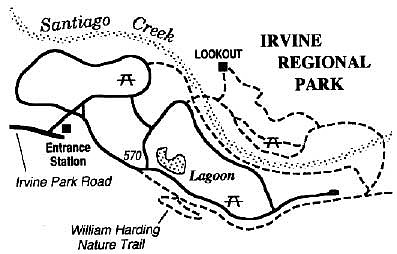 Facebook
Facebook
 X
X
 Instagram
Instagram
 TikTok
TikTok
 Youtube
Youtube
For more than a century, Irvine Park has drawn Orange Countyans up into the foothills of the Santa Ana Mountains. Once a meeting place for the early settlers -- then known as the Picnic Grounds -- it became Orange County Park in 1897 when early rancher James Irvine donated 160 acres of prime oak and sycamore groves fronting Santiago Creek. Today's park, now titled Irvine Regional Park, has grown to 477 acres and hosts thousands of visitors on busy weekends. The park is accessible to San Diegans by way of Interstate 5 north to Jamboree Road, Jamboree north to its terminus at Santiago Canyon Road (just east of the city of Orange), and Irvine Park Road, which leads directly to the park entrance.
Aside from picnic and playground areas, a boating lagoon, a small zoo, and wildlife and historical exhibits, it's possible to find some off-the-beaten-path hiking here. Several miles of paved and unpaved trails suitable for bicycling, hiking, and horse riding follow Santiago Creek and wind around the perimeter of the park. For a nice, short introduction on foot, try this:
Start at the Nature Trail parking area (bear right after passing the entrance station to reach it). Head up the paved path a short distance to the first diversion -- the William Harding Nature Area. Here a 0.3-mile self-guiding trail cut into a shady, north-facing hillside introduces you to some of the common chaparral and oak-woodland shrubs and trees.
On the paved path again, continue east along the perimeter of the park until you reach a split. Bear left and head across Santiago Creek on a concrete crossing. Despite its nearly 100 square miles of drainage, the creek's broad, open bed is almost always dry. This is partly because much of the upstream surface flow has already seeped into porous soils, and partly because Santiago Reservoir impounds water upstream. There's still enough water underground, however, to keep the oaks, sycamores and other trees in the park looking healthy. The biggest oaks in the park are as old as 800 years.
On the far side of the creek, before you reach a small outcrop of sandstone, a dirt road veers right to climb a dry bluff. Take this and continue about 0.4 mile to the "lookout," a small shade ramada overlooking the park, a good place for a restful pause.
Complete the circuit by heading down the log stairway toward the walk-in picnic area below, and then crossing the creek bed via a paved path. If time allows, you can wander at length among the park's central attractions, all of which are clustered around the lagoon.


For more than a century, Irvine Park has drawn Orange Countyans up into the foothills of the Santa Ana Mountains. Once a meeting place for the early settlers -- then known as the Picnic Grounds -- it became Orange County Park in 1897 when early rancher James Irvine donated 160 acres of prime oak and sycamore groves fronting Santiago Creek. Today's park, now titled Irvine Regional Park, has grown to 477 acres and hosts thousands of visitors on busy weekends. The park is accessible to San Diegans by way of Interstate 5 north to Jamboree Road, Jamboree north to its terminus at Santiago Canyon Road (just east of the city of Orange), and Irvine Park Road, which leads directly to the park entrance.
Aside from picnic and playground areas, a boating lagoon, a small zoo, and wildlife and historical exhibits, it's possible to find some off-the-beaten-path hiking here. Several miles of paved and unpaved trails suitable for bicycling, hiking, and horse riding follow Santiago Creek and wind around the perimeter of the park. For a nice, short introduction on foot, try this:
Start at the Nature Trail parking area (bear right after passing the entrance station to reach it). Head up the paved path a short distance to the first diversion -- the William Harding Nature Area. Here a 0.3-mile self-guiding trail cut into a shady, north-facing hillside introduces you to some of the common chaparral and oak-woodland shrubs and trees.
On the paved path again, continue east along the perimeter of the park until you reach a split. Bear left and head across Santiago Creek on a concrete crossing. Despite its nearly 100 square miles of drainage, the creek's broad, open bed is almost always dry. This is partly because much of the upstream surface flow has already seeped into porous soils, and partly because Santiago Reservoir impounds water upstream. There's still enough water underground, however, to keep the oaks, sycamores and other trees in the park looking healthy. The biggest oaks in the park are as old as 800 years.
On the far side of the creek, before you reach a small outcrop of sandstone, a dirt road veers right to climb a dry bluff. Take this and continue about 0.4 mile to the "lookout," a small shade ramada overlooking the park, a good place for a restful pause.
Complete the circuit by heading down the log stairway toward the walk-in picnic area below, and then crossing the creek bed via a paved path. If time allows, you can wander at length among the park's central attractions, all of which are clustered around the lagoon.
